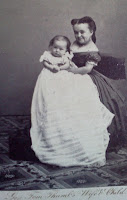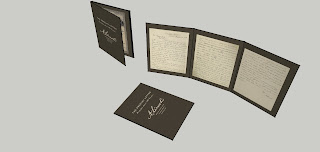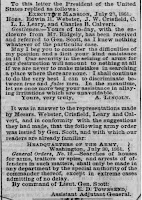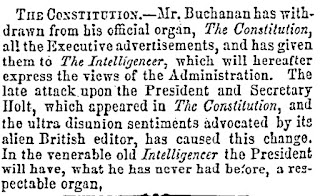Diary of Elizabeth Lord Cogswell Dixon 1845-1847 was published in White House History, Issue 33. This is her entry for Feb 8, 1846.
At the end of this post is a link to her entire diary.
February 8, 1846
It is a most beautiful building in Washington, after the Capitol, which I do think more imposing than any I know of, certainly the most so in the country and far more so than the Capitol at Rome.
My new friend, Mr Washington, who is the chief auditor, took us over the whole building, showing us the system of accounts for all the Post Offices in the United States, which is stupendous and all written most exquisitely without a blemish also the first book of accounts in Benjamin Franklin's handwriting.
He took us into his own room which is very pleasant and up flights of marble stairs for the whole building is marble showed us the secretaries, all his inventions which turn down and form a desk, all uniform in sizes and colors, which Lord Ashburton pronounced more perfect than anything he had ever seen.
He took us into the dead letter offices where two men sit from one year's end to the other opening dead letters which become dead after about six months and after every possible inquiry.
They contain all sorts of things and three of the men found a $50 bill while we were there. One watches the other and there is no deception. The paper lady was in on the pattern of the cloth also. This little lock of hair probably sent, perhaps from a father to a child or mother to a daughter, or to a little sister. Some were quite touching, as one was from a wife to her husband with a lock of hair of each of her children and piece of her newest one with the ages and date of each lock of hair, which was all beautiful. I wish the poor little girl could have received her paper girl.
There were some things very valuable sent by a mother to her son in this country from Germany with only his initials on the package "F.B" Pensacola Florida. There was a beautiful set of ruby earrings and an elegant pin with cipher in diamonds, also some very superior rings of great beauty and values and last a daguerreotype likeness of the father and mother both agreeable looking person. It will be a "treasure trove" should they be successful in finding the owner.
We saw a great iron chest full of money collected from letters and a closet full of other articles franked or forwarded with a pigeon holes for each state, there were cookery books, pocket books, gifts of different kinds and one theatrical costume, also cheeses have at different times been sent but could hardly have a place among the antiquities. The letters that are finally pronounced defunct are opened and their contents taken out and they are torn in pieces & destroyed.
Mr. Washington then took us into the room of the Postmaster General, Cave Johnson, who is a fine venerable looking man rather the belle of the Cabinet for beauty. He is tall with silvery hair & a fine gentlemanly person. We met the assistant Postmaster General a very pleasant man and friend of Mr. Kinney's for whom he inquired. We were presented to Mr. Johnson who insisted us to sit down and we made a short call and then made his adieu.
We had a peep into Mr Brown's room who has the appointing office to do & also cutting off of the heads and then we peeped into another office of one of the clerks who had the most splendid geranium I ever saw it covered the whole window which stretched nearly from the ceiling to the floor and was very fragrant. I wonder if it was the clerk who wrote so exquisitely both are said to be characteristic of refinement.
Link to Diary of Elizabeth Dixon:
https://www.whitehousehistory.org/introduction-to-the-transcription-of-the-washington-diary-of-elizabeth-l-c-dixon



































